Hummingbirds found in Texas, USA
Hummingbirds found in the USA (by U.S. State) … Canada … Mexico … Puerto Rico … Jamaica … Honduras
Hummingbird Information … Hummingbird Species Photo Gallery
Most migrants arrive in March to early April and leave in September to October. Vagrants from Central and South America are sometimes seen.
Identification of many hummingbird species is often most easily done by the males’ distinctive glossy throat patches, which range from orange, red, purple, green, blue. These colorful patches may be restricted to only the throat or in some species may extend over the crown or even over most of the head. However, in poor light conditions, these color patches may simply look greyish/black, which makes identification more difficult. Females and juveniles across species often look alike, but some physical clues can often be found.
WHITE Hummingbird Sightings (Leucistic / Albino)
(Amazilia yucatanensis) – Natives breeders in the lower Rio Grande Valley of southernmost Texas. In the winter, they are rare all along the Texas coast.
The male’s throat is a metallic golden green and the red, dark-tipped bill is straight and slender. Back and head are mostly metallic olive. The lower chest ranges in coloration to whitish with various shades of grey or green, or buffy (yellowish-brown).
The tail and primary wing feathers are rufous (reddish-brown) and slightly forked. The underwing is white.
The female is generally less colorful than the male and has a a dark upper bill
Broad-billed Hummingbirds (Cynanthus latirostris) – Possible natives as adult pairs have been seen at a variety of locations. These mostly Mexican hummingbirds venture into the United States regularly; they mostly visit the southern parts – but a few vagrants travel as far north as Wisconsin.
The male is glossy green above and on the chest. He has a deep blue throat. His straight and slender beak is red with a black tip. His slightly forked tail is dark above, and the under tail feathers are white.
The female is less colorful than the male. Her throat, chest and belly are light to medium grey. She has a white stripe over each eye.

Blue-throated Hummingbirds (Lampornis clemenciae) – Native breeders in the Big Bend National Park.
The upper plumage is dull green, fading to a medium grey on the underside. It has white stripes behind the eyes and a narrower stripe extending backward from the corner of its relatively short bill, next to a blackish cheek patch.
The male can be identified by the iridescent blue throat patch (gorget), which may appear black or grey color in poor light.
The female and young have grey throats.

Magnificent or Refulgent Hummingbirds (Eugenes fulgens) – Native breeders in Big Bend National Park.
These are large hummingbirds and can often be identified by their size alone.
The male has a metallic green throat and a black chest. His forehead and crown are purple and the back is dark green.
The female plumage is less bright. Her chest is solid grey. Her back and crown are olive green. Her tail feathers are pearl-grey tipped.

Lucifer Hummingbirds (Calothorax or Trochilus lucifer) – Natives / Rare – In Texas (mostly western parts), they are often seen near flowering agaves in Big Bend National Park and in the Davis Mountains – mostly at elevations of about 3,500–5,500 feet (~ 1,000 – 1,600 m). These migratory birds arrive in March or early April for the breeding season and leave early fall (early October) to winter in western Mexico.
ID: This bird is most easily recognized by its relatively large head; long, thin and down-curved bill; small wings and small, tapered body. Its tail is long, narrow and deeply forked, extending well beyond the wingtips; and the forehead is green. The back is a drab grey-green. There is a pale buffy band across the chest. Adults have a white streak behind the eyes.
The male has a glossy magenta to blue-violet throat patch (gorget) that is elongated at the sides and is bordered white on both sides (note: the purple gorget looks black in poor light). The neck and the chest are white. The under plumage is whitish / greyish with greenish and rusty sides.
The female is larger in size, lacks the flashy throat patch of the male, and is light brown around the chest and throat area.
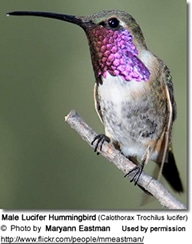
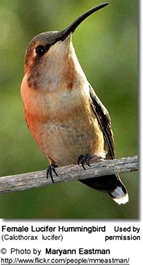
Ruby-throated Hummingbirds (Archilochus colubris) – Native Breeders – They usually arrive in the eastern half of Texas (their primary breeding territory) in March and leave in October to return to their wintering territories. Migrating males are usually the first to arrive and the first to depart. The females and the young usually follow about two weeks later.
The male has a ruby-red throat, a white collar, an emerald green back and a forked tail.
The female has a green back and tail feathers that are banded white, black and grey-green.

Rufous Hummingbirds (Selasphorus rufus) – Mostly occur in west Texas where they are common in spring and fall; some winter on the coast. These hummingbirds are usually found in gardens and at feeders. These birds are fearless, and are known for chasing away other hummingbirds and even larger birds, or rodents away from their favorite nectar feeders and flowers.
Males can easily be identified by their glossy orange-red throats.
Females have whitish, speckled throats, green backs and crowns, and rufous, white-tipped tail feathers.
Rufous Hummingbird versus the similar Ruby-throated Hummingbird (Identification)
Black-chinned Hummingbirds (Archilochus alexandri) – Native breeders in the western half of Texas; a few spend the winters along the coast.
The male has a black, shimmering throat with a purple edge and pale feathers below that create a collar. However, unless the light is just right, the head looks all black. His back is green and there are some green feathers covering the chest.
The female is pale below (sometimes with a slightly speckled throat) and her back is green.

Anna’s Hummingbirds (Calypte anna) – Rare, non-reeding fall / winter visitors
One of the larger and the most vocal hummingbirds in the United States, where it is the only species to produce a song; specifically the males produce a complex series of scratchy noises, sounding like a sharp “chee-chee-chee; when moving from flower to flower, they emit toneless “chip” vocalizations. All other hummingbirds in the United States are mostly silent.
They are well known for their territorial behavior; the male makes elaborate dive displays at other birds and sometimes even at people. At the bottom of their dives, they produce high-pitched loud popping sounds with their tail feathers.
Males have glossy dark rose-red throats and crowns, which may appear black or dark purple in low light. The underside is mostly greyish; and the back metallic green.
Females have light grey chests with white and red spotting on the throat, greenish back and white tipped tails.
They resemble the Costa’s Hummingbirds, but the male’s Costa’s Hummingbird’s gorget (throat feathers) is longer than that of the Anna’s. They are larger than the Rufous Hummingbirds and lack the rusty coloration of the Rufous Hummingbirds.
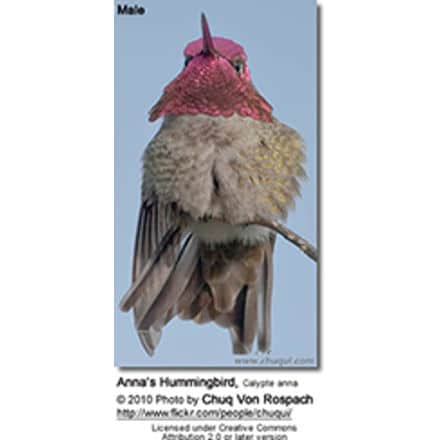
Broad-tailed Hummingbirds (Selasphorus platycercus) – Native breeders in the mountains of west Texas.
Males can most easily be identified by their iridescent, rose-red throats, white chest feathers and metallic green back and crown and their rounded tails. The males’ tails make whistling noises in flight.
Females lack the flashy throat patch of the male and are mostly pale below. Their white-tipped outer tail feathers are rust-colored close to the body and blackish in the center; the tail feathers in the center range from green to blackish.

(Anthracothorax prevostii) – Increasingly frequent vagrants and extremely rare residents in Texas and accidental vagrants to other U.S. states. These hummingbirds are native to Mexico, Central America down to Costa Rica, and some Caribbean islands. However, juveniles especially have been venturing into the United States. Several young birds have been sighted in southern Texas (coastal Texas, Corpus Christi, lower Rio Grande Valley).
Adult Males are mostly glossy green, more yellowish brown on the sides (flanks) and the vent. They have broad blue throat patches that extend to below the chest. These throat patches may look black in poor light conditions. The outer tail feathers range in color from an a deep purple tipped with black, or orangey-red to magenta.
Females and Juvenile Males have broad magenta and glossy dark blue bands to the outer tail feathers. The outer 3 to 4 tail feathers are narrowly tipped. The back bronze-green. Below they are whitish with a dark middle stripe that changes from black at the chin to blue-green on the throat.
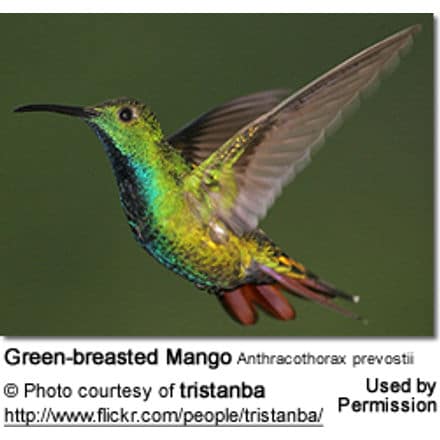
(Amazilia beryllina ssp. viola) – Native, Rare and local summer resident in Arizona, New Mexico and Texas. In Texas, they have been seen in Big Bend area. They nest from July through September.
ID: They have shimmering green feathers from their bill to their rump, where the color changes to rufous and extends through their tail feathers.
The tail feathers have a shiny, iridescent purple tint that blends with the rufous color.
Males and females look alike.
Violet-crowned Hummingbirds (Amazilia violiceps ssp. ellioti) – Rare vagrants – Occurs primarily in Mexico and southwestern to south central United States. They are rare and localized in Texas, where they are found in the extreme west, on the Edward’s Plateau, in south Texas and occasionally along the coast. Have been recorded in El Paso, Texas.
ID: This hummingbird is most easily identified by its white under plumage and iridescent bluish-violet crown (from where it gets its name). The back is emerald green. The tail is dark brown / olive green. The straight and very slender bill is reddish / orangey with a black tip.
Females and juvenile birds look similar to the males, but their plumage is generally less colorful than that of the male and they have a lighter and greener crown.
Costa’s Hummingbirds (Calypte costae) – Native Breederd. Generally uncommon. Have been recorded in El Paso in far west Texas.
Males can easily be identified by the glossy purple crown and long, conspicuous throat feathers that project markedly down the side of the throats, giving it an elongated “moustache” appearance. The back is metallic green.
Females have greyish-green crowns (fop of the head) and backs. The chin and the plumage below are whitish, except for some black spotting on her throat. Her flanks are buffy-colored. She has a dark tail with white tips on the outer tail feathers.
They resemble the Anna’s Hummingbirds, but the male’s gorget (throat feathers) is longer than that of the Anna’s.
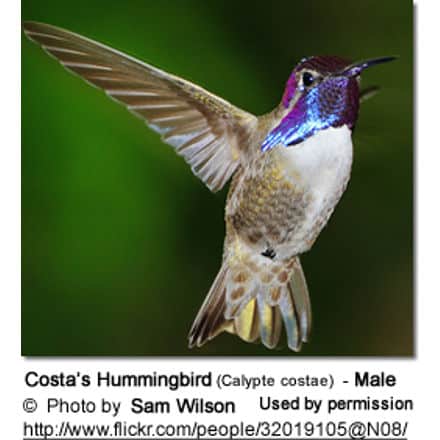
Calliope Hummingbirds (Stellula calliope) – Commonly found in El Paso in August; and in Big Bend National Park in August and September.
The smallest breeding bird in North America. They are most easily confused with the Rufous Hummingbirds and the Broad-tailed Hummingbird.
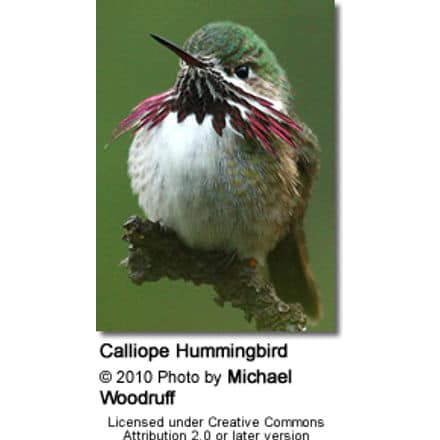
Allen’s Hummingbirds (Selasphorus sasin) – Occasional visitors as per the few winter records from banders. Historically, these birds nested in coastal California and wintered in Mexico; but more and more of them are remaining in California year-round or are traveling to the eastern United States for the winter.
The male has a throat that ranges in color from orange-red to yellow-orange, a back that is bright green, a rump that is rufous and its tail feathers are rufous tipped in black.
The Allen’s Hummingbird is often confused with the Rufous Hummingbird, but the Allen’s can be identified by the green back whereas the Rufous Hummingbird has a coppery back.
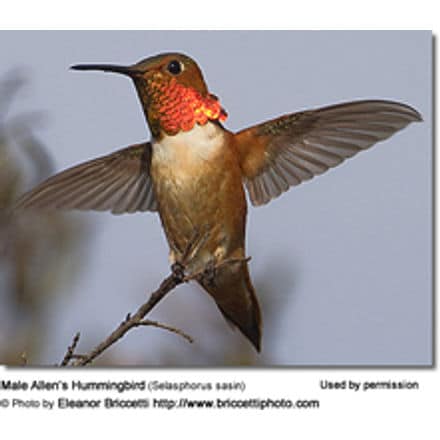
White-eared Hummingbirds (Basilinna leucotis) – Rare – A few records for far western Texas
ID: Both the male and female White-eared Hummingbird have a prominent white ear stripe (more boldly colored in the male) for which this species was named.
The back and chest are mostly green. The undertail feathers are whitish. The thin, long, straight bill is red at the base. The male can be identified by his a turquoise throat, turquoise and white spotted chest and flanks, deep green back, white belly and chest.
The female has a white or cream colored throat that is speckled with green, a whitish belly, deep green crown and a drab green back.
Green Violetear Hummingbirds (Colibri thalassinus) – Rare / Accidental – Only a few scattered records exist in the state of Texas.
Plumage above is grass green graduating into bronze on the rump and uppertail. Wide violet central spot on the upper chest; violet-blue band along the chin that often connects to the violet-blue “ear”. Square tail is slightly notched with a broad dark blue band at the end.
Is it a Hummingbird or an Insect?
The Hawk Moths (often referred to as “Hummingbird Moth”) is easily confused with hummingbirds, as they have similar feeding and swift flight patterns. These moths also hover in midair while they feed on nectar.
Moths have a couple of sensors or “antennas” on top of the head, which are key identifiers.

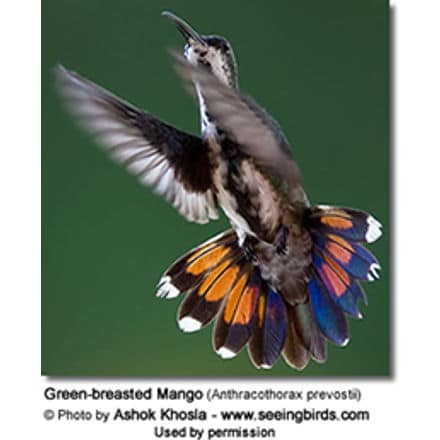
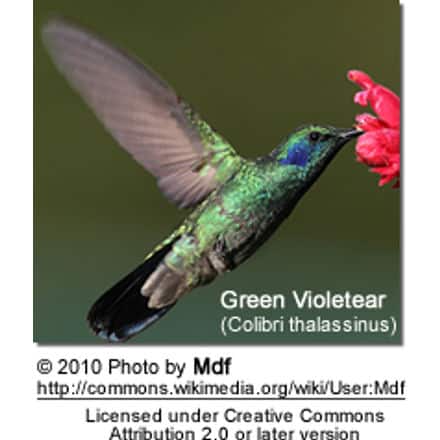
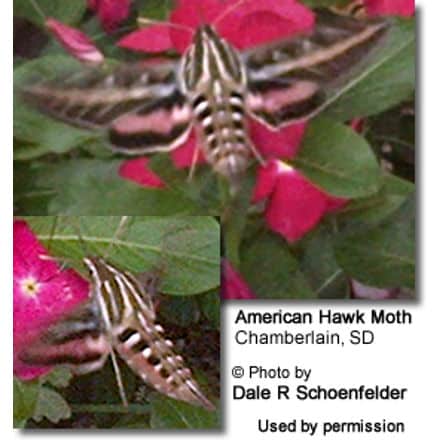

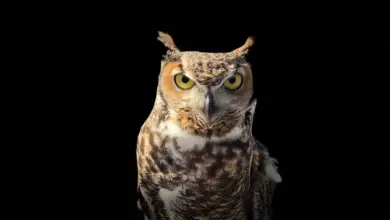
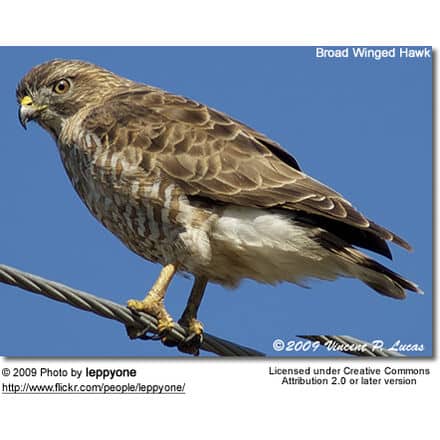


My story: In 2007, I was lonely and in Corpus Cristi, Texas. I ain’t kidding, a baby-blue hummingbird hovered less than 2 feet in front of me. I would move and stop and the hummer would keep pace with me and hover. And any time I’m feeling lonely, I can step outside and pretty soon I will see this same baby-blue hummer. By the way, I still live in Texas, just, now it is North of Houston.
My question is: What kinda species is this hummer. It was baby-blue in color all over.